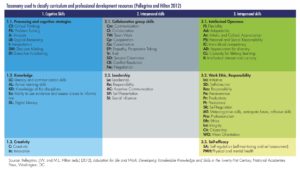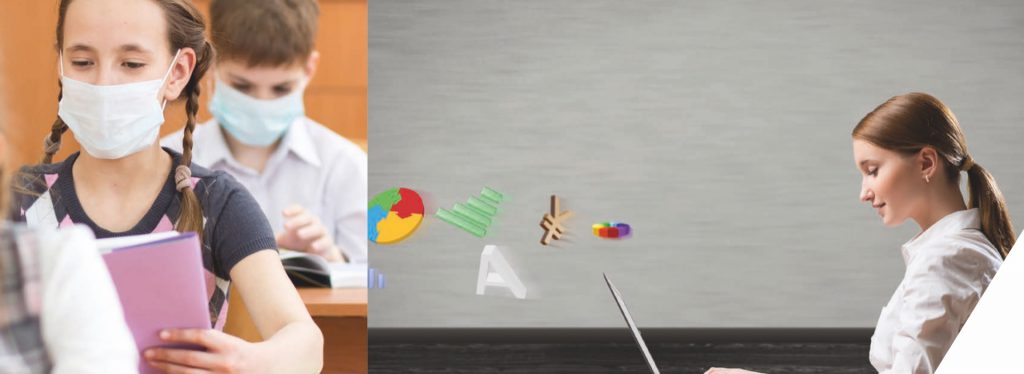The pandemic has posed huge challenges in this new decade, especially in the context of education, affecting nearly 1.6 billion students in more than 190 countries. The closure of schools, universities and training centres has affected 94% of the world’s student population. Confinement due to the coronavirus has reshaped the paradigm under which educational systems have been operating, forcing the implementation of distance learning methods that have allowed teachers and students to continue with scheduled lessons. After several months in these conditions, it became vital to design a procedure that responds to the challenges that have arisen in this global crisis. The digital gap in education has widened, and a large proportion of students have found themselves at risk of exclusion due to not having the electronic devices needed to complete course work from their homes. Countries have proposed multiple measures during the academic year, but there has been a persistent need to establish alternative ways of learning aimed at those students who do not possess the required technological tools.
Many institutions have worked to meet the challenges posed by the school closures. Here, we focus on the product that resulted from the joint efforts of the OECD, the World Bank, the HundrED Organisation and the Harvard School of Education. The goal was to build an informed guide for educational leaders for the new year ahead: 2020/2021. The development of the document was led by Fernando Reimers of the Global Education Innovation Initiative at Harvard University, Andreas Schleicher of the Organisation for Economic Co-operation and Development (OECD), Jaime Saavedra of the World Bank and Saku Tuominen of HundrED.
At the end of March 2020, the first module, based on a survey conducted between 18 and 27 March, was published, with the aim of assessing emerging issues and priorities in the system. The second module entailed the launch of educational resources to support the continuity of distance training and learning during lockdown. The resources were compiled based on the responses obtained from the surveys carried out in the first module. The subsequent modules cover all the initiatives for disseminating educational content through traditional media, such as radio and television. This module presents a guide to the effective application of resources through these media.
The guide was compiled on the basis of a survey of 333 participants in 99 countries, who identified the educational resources that had been most useful to them in the distance learning process. Nineteen alumni of the Harvard Graduate School Master’s programme assessed the tools chosen by the teachers surveyed. The evaluation team analysed each of the tools, classifying them by subject, level and language. Each teaching resource classified was coded in terms of required competences.

The selected resources were classified into three main categories:
- Curricular resources. These refer to lessons, interactive learning content, videos, and other resources that involve the acquisition of knowledge and skills. A total of 72 platforms are compiled in this guide, which refer to various resource repositories.
- Resources for professional development. These are support resources for teachers and parents that serve as a learning guide in the distance learning process. A total of 21 development resources are included.
- Tools to manage the teaching and learning process. Communication tools and tools for learning management are included.
The coding and taxonomy used as a reference is from the study carried out by Pellegrino and Hilton in 2012, “Education for Life and Work: Developing transferable Knowledge and Skills in the 21st Century”.
The resources were classified and coded based on the following parameters:
- Cognitive skills. They include three groups of competences: cognitive processes and strategies, knowledge and creativity. On this basis, skills such as critical thinking, literacy, reasoning, argumentation and innovation are developed.
- Cognitive processes and strategies. The following competencies were coded: critical thinking (CT), problem solving (PS), analysis (A), logical reasoning (LR), interpretation (I), decision-making (DM) and executive functioning (EF).
- Knowledge. The competences included are: literacy and communication skills (LC), active listening skills (AL), knowledge of disciplines (KD), ability to evaluate errors in information (EV) and digital literacy (DL).
- Creativity. This category encompasses creativity (C) and innovation (In).
- Interpersonal skills. It includes two sets of competences: teamwork and leadership. It is characterised by combining competences such as communication, collaboration, responsibility and conflict resolution.
- Collaborative group skills. This includes: communication (Cm), collaboration (Cl), teamwork (TW), cooperation (Cp), coordination (Cp), empathy, perspective and dialogue (EP), trust (Tr), service orientation (SO), conflict resolution (CR), and negotiation (Ne).
- Leadership (Le). This covers: responsibility (Re), assertive communication (CA), self-presentation (SP) and social influence (SI).
- Intrapersonal skills. Reference is made to three groups of competences: intellectual openness, work ethic and conscience, and self-assessment. These groups include skills such as flexibility, initiative, diversity and meta-cognition (the ability to reflect on one’s own learning and make necessary adjustments). There are two skills included in this study for coding the chosen resources on the basis of:
- Intellectual openness. This combines the following competences: flexibility (Fl), adaptability (Ad), artistic and cultural appreciation (Ar), personal and social responsibility (PS), intercultural competence (IC), appreciation of diversity (AD), capacity for lifelong learning (CL) and intellectual interest (Il).
- Work ethic and responsibility. This encompasses initiative (Ini), self-direction (SD), responsibility (Res), perseverance (Pe), productivity (Pr), persistence (Pt), self-regulation (SR), meta-cognitive and reflective skills (MT), professionalism (Pro), ethics (Eth), integrity (Int), citizenship (Cit) and work orientation (WO).
- Self-Efficacy. Self-Assessment (SA) and Physical and Mental Health (PMH).
A total of 113 platforms were selected and evaluated, divided into two tables. The first table includes the curricular resources, and the second covers the professional development resources evaluated according to the following criteria: language, courses, subjects, cost (free or paid), cognitive skills, interpersonal skills and intrapersonal skills.
Among the platforms that include the three groups of skills, the following are worth highlighting:
As curricular resources:
- https://www.icourse163.org/ This is an online platform for MOOC courses. It hosts the courses of China’s top universities.
- https://open.163.com/ This is one of the largest non-governmental MOOC platforms in China. It includes not only courses in Chinese on all subjects, but also training in English.
- http://s1k.eduyun.cn/ Under the name “One Teacher One Course”, this government educational platform offers countless courses and multimedia resources to provide curricular support to teachers throughout China. Aimed at primary, secondary and special education.
- https://pangeaeducation.org/covid19 Aimed at the African market, this is a free platform for literary content, available in more than 10 languages.
- http://www.telesecundaria.sep.gob.mx/ Telesecundaria is a Mexican school programme for students in years seven through nine. It was established by the Mexican government in the 1960s to cater for students in rural areas. This programme enables students to receive lessons using a television installed in a classroom. All the multimedia resources available in the programme can be accessed through the website. To have access, students must be registered from the beginning of the school year.
- http://www.librosdetexto.sep.gob.mx/ This platform provides access, free of charge, to all the textbooks created and used by the Mexican Department of Education. Content for all subjects is available, from pre-school to year nine.
- http://www.alianzaeducativa.edu.co/ Alianza Educativa has developed a collection of learning resources aimed at all those students with access to the Internet. It is a repository organised by year and by academic programme. Each level links to an open topic on Google available for download.
As professional development resources:
- http://www.knotion.com/ This platform is aimed at schools and teachers interested in incorporating teaching design into their pedagogical model.
The third table in the guide lists all the tools used by students, teachers and families during the lockdown period, and they are classified according to the following categories: language and cost. Among them, we highlight: Microsoft One Note, Microsoft Teams, Ed Dojo, Zoom, Moodle, Seasaw, Google-Suite, Google Classroom, Kahoot, Nearpod and FlipGrid.
After careful analysis, approximately half of the resources included in the survey were retained, having been considered to be of high quality by the review team. It is considered that the education crisis generated by the pandemic is far from over, since many countries have not yet announced the exact date for the school re-openings. And given the ongoing outbreaks of the virus, the educational landscape is paralysed, pending decisions by the authorities.
Urgent action is needed by all if a learning crisis is to be prevented. And against a backdrop of uncertainty in relation to school openings, this document is established as an essential guide to support teachers in the training and learning process. It can potentially enrich a proposal for face-to-face, hybrid or distance learning, regardless of the social divide caused by the contextual conditions in various regions, which may restrict efforts to make the most of the resources that this taxonomy proposes.
Access the full document:

Are you involved in any initiative that aims to ensure learning continuity during the global Covid-19 crisis? Share your initiative HERE!






